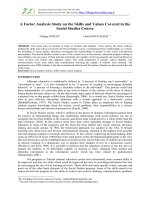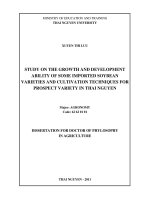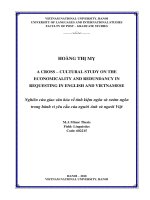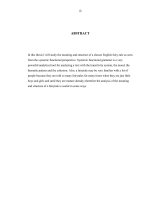Phase II study on the efficacy and safety of Lapatinib administered beyond disease progression and combined with vinorelbine in HER-2/neu– positive advanced breast cancer: Results of the
Bạn đang xem bản rút gọn của tài liệu. Xem và tải ngay bản đầy đủ của tài liệu tại đây (416.8 KB, 7 trang )
Thallinger et al. BMC Cancer (2016) 16:121
DOI 10.1186/s12885-016-2171-y
RESEARCH ARTICLE
Open Access
Phase II study on the efficacy and safety of
Lapatinib administered beyond disease
progression and combined with vinorelbine
in HER-2/neu– positive advanced breast
cancer: results of the CECOG LaVie trial
Christiane Thallinger1,2, Istvan Lang3, Cvetka Grasic Kuhar4, Rupert Bartsch1, Christian F. Singer5, Lubos Petruzelka6,
Bohuslav Melichar7, Regina Knittelfelder2, Thomas Brodowicz1,2 and Christoph Zielinski1,2*
Abstract
Background: Vinorelbine constitutes effective chemotherapy for metastatic breast cancer (MBC) and acts synergistically
with trastuzumab in HER-2/neu positive disease. The present study was set out to evaluate the efficacy and safety of
vinorelbine when combined with lapatinib, an anti-HER2 tyrosine-kinase inhibitor, as late-line regimen administered
beyond previous disease progression on prior lapatinib in patients with HER-2/neu- positive MBC.
Methods: The CECOG LaVie study was designed as open-labeled, single-arm, multicenter phase II trial. Patients had to
be pretreated with lapatinib plus chemotherapy, and received lapatinib at a daily dose of 1250 mg in combination with
vinorelbine 20 mg/m2 i.v. on days 1 and 8 of a three-week cycle until disease progression, intolerable toxicity or
withdrawal of consent. Progression-free survival (PFS) was defined as primary study endpoint; secondary endpoints
included overall survival (OS), response rate according to RECIST 1.1, and safety. The study was terminated early due to
poor accrual.
Results: A total number of nine patients were included; lapatinib administered beyond disease progression combined
with vinorelbine resulted in a median PFS of 7.7 months (95 % CI 0.56-14.91) and a median OS of 23.4 months (95 % CI
16.61–30.13), respectively. Partial remission was seen in one of nine patients, three patients had stable disease of > six
months, whereas the remaining five patients had primary disease progression. In two patients, modification of
vinorelbine dose due to toxicity became necessary; no dose modification was needed for lapatinib. The majority
of reported adverse events (AE) were grade 1 and 2 in severity with diarrhea being the most commonly observed AE
Conclusion: In this heavily pretreated patient population, combination of vinorelbine plus lapatinib showed
encouraging activity and was characterized by an acceptable safety profile. Despite the low patient number,
lapatinib plus vinorelbine may constitute a potential treatment option in heavily pretreated patients with
HER-2/neu-positive MBC previously exposed to lapatinib.
Trial registration: EudraCT number 2009-016826-15, (15. 10.2009)
Keywords: Metastatic Breast Cancer, HER-2/neu, Lapatinib, Vinorelbine, Chemotherapy
* Correspondence:
1
Department of Medicine I and Comprehensive Cancer Center, Clinical
Division of Oncology, Medical University Vienna – General Hospital,
Währinger Gürtel 18-20, 1090 Vienna, Austria
2
Central European Cooperative Oncology Group (CECOG), Schlagergasse 6/6,
1090 Vienna, Austria
Full list of author information is available at the end of the article
© 2016 Thallinger et al. Open Access This article is distributed under the terms of the Creative Commons Attribution 4.0
International License ( which permits unrestricted use, distribution, and
reproduction in any medium, provided you give appropriate credit to the original author(s) and the source, provide a link to
the Creative Commons license, and indicate if changes were made. The Creative Commons Public Domain Dedication waiver
( applies to the data made available in this article, unless otherwise stated.
Thallinger et al. BMC Cancer (2016) 16:121
Background
Breast cancer is a heterogeneous disease encompassing
distinct biological subtypes with distinct natural histories.
The human epidermal growth factor receptor-2 (HER-2/neu)
positive breast cancer subtype accounts for 10–15 % of all
breast cancer cases. In the pre-trastuzumab-era, early-stage
HER-2/neu positive disease had the second poorest prognosis after triple-negative breast cancer [1] thus leading to an
accumulation of HER-2/neu positive breast cancers in the
advanced disease setting [2, 3]. When highly expressed at
membrane level, HER-2/neu undergoes hyperdimerization
with itself or with other receptors of the erbB family thus activating various mitogenic pathways, specifically phosphatidylinositide 3-kinase (PI3K/AKT) and mitogen-activated kinase
(MAPK) [4]. These pathways in terms induce continuous cell
proliferation and new vasculature formation thus resulting in
an aggressive phenotype with poor prognosis.
Trastuzumab, a monoclonal antibody targeting the
HER-2/neu oncoprotein yields - in combination with various chemotherapies – significant and clinically relevant
prolongation of progression-free survival (PFS) and overall
survival (OS) as compared to chemotherapy alone. The
varying interaction of trastuzumab with different chemotherapeutic drugs has been subject of various reports,
which have indicated that such combination treatment
might result in additive or even synergistic effects [5].
Of note, synergy was suggested for the combination of
trastuzumab and vinorelbine, [6] which is popular due
to its efficacy and ease of administration in conjunction
with limited toxicity.
Despite high activity, resistance to trastuzumab will
eventually occur during the course of treatment in metastatic HER-2/neu-positive disease, which has led to the
development of various alternative anti-HER2 compounds
including tyrosine-kinase inhibitors (TKIs) such as lapatinib and second-generation antibodies such as pertuzumab
or T-DM1.
As member of the 4-anilinoquinazoline classes of kinase inhibitors, lapatinib reacts with the ATP binding site
of EGFR, and HER2/neu thus resulting in inhibition of
autophosphorylation and subsequent proliferative signaling [7]. Lapatinib is currently approved for the treatment
of patients with HER-2/neu positive MBC who progressed
on prior trastuzumab-based therapy or as first-line treatment in combination with letrozole in luminal B/HER-2/
neu positive disease [8].
Treatment of MBC relies upon cascade-like sequential
administration of cytotoxic compounds, thereby offering a
chance for prolonged disease control [9–11]. In HER-2/
neu positive breast cancer, a prolongation of PFS by the
continuation of trastuzumab beyond progression under
the proviso of a change of the hitherto administered cytotoxic drug was demonstrated (treatment in multiple-lines;
TML) [12].
Page 2 of 7
Vinorelbine constitutes effective chemotherapy for metastatic breast cancer (MBC) and acts synergistically with
trastuzumab in HER-2/neu positive disease.
Based upon these considerations, it seemed reasonable
to hypothesize that the combination of lapatinib plus vinorelbine could also result in significant anti-tumor activity
in the challenging setting of late-line treatment in patients
with HER-2/neu positive MBC pretreated with trastuzumab and lapatinib. Indeed, encouraging activity of lapatinib
plus vinorelbine combination therapy has been already
demonstrated in two phase II trials [13, 14] while the
concept of lapatinib beyond disease progression was not
investigated henceforth.
Thus, the objective of this phase II trial was to assess activity and safety of lapatinib plus vinorelbine in HER-2/
neu positive patients with MBC who had progressed on
previous lapatinib-based treatment.
Methods
Study design
This multicenter, open-labeled, single arm phase II trial
included female HER-2/neu positive patients with MBC.
Patients were enrolled between October 2010 and August
2012 from 7 sites in 4 countries.
All eligible patients with MBC were pretreated with
lapatinib in combination with various cytotoxic drugs excluding vinorelbine. Lapatinib was administered beyond
disease progression and prescribed at a dose of 1250 mg
p.o. once daily on a continuous basis. Vinorelbine was administered at a dose of 20 mg/m2 by intravenous infusion
on days one and eight of a three-week cycle until disease
progression or the necessity of discontinuation of study
treatment due to unacceptable toxicity, withdrawal of consent, loss to follow up, or death.
The primary aim was to evaluate PFS in heavily pretreated
MBC patients receiving the combination of lapatinib
and vinorelbine with a descriptive intent only.
Patient population
Eligible patients were women ≥18 years of age with histologically or cytologically confirmed HER2/neu positive
(HER2/neu 3+ as defined by immunohistochemistry and/or
HER-2/neu gene amplification as defined by fluorescence in
situ hybridization) MBC with at least one measureable lesion according to Response Evaluation Criteria in Solid
Tumors version 1.1 (RECIST v.1.1). Prior lapatinib-based
treatment in first- or second-line therapy for metastatic
disease was mandatory. Patients were required to have
adequate organ and bone marrow function, Eastern
Cooperative Oncology Group performance status of 0–1,
life expectancy of more than 12 weeks and an adequate
left ventricular ejection function of at least 50 % at
baseline, as measured by either echocardiography or
MUGA scan.
Thallinger et al. BMC Cancer (2016) 16:121
Exclusion criteria included concomitant endocrine therapy, previous radiotherapy for metastatic disease in order
to allow for appropriate bone marrow reserve within frame
of the current trial, active cardiac, hepatic or biliary disease
and diseases or surgeries affecting gastrointestinal function.
Patients undergoing concurrent treatment with anticancer
or investigational agents, females pregnant or lactating,
and those with a peripheral neuropathy of grade 2 or
greater were also excluded. Any medication that was
considered necessary for the patient’s welfare and was
not expected to interfere with the evaluation of study
treatment could be given at the discretion of the investigator. Other antitumor therapies were not permitted.
The study was approved by independent ethics committees and was conducted in accordance with the principles
of the Declaration of Helsinki and the Note of Guidance
on Good Clinical Practice. All patients provided written
informed consent prior to study entry.
The study was approved by the following ethics
committees: Ethikkommission des KH der Elisabethinen,
Ethikkommission des Landes Salzburg, Ethikkommission
der Medizinsiche Universität Wien, Etická komise FN
Olomouc, Etická komise Všeobecné fakultní nemocnice,
Medical Research Council Ethics Committee for Clinical
Pharmacology, National Medical Ethics Committee of the
Republic of Slovenia.
Study endpoints
Baseline tumor assessment (CT or MRI) of the chest,
abdomen and brain were performed within 28 days before first study drug application and once every 6 weeks
during treatment phase thereafter. Tumor response data
were assessed by the investigator according to RECIST
criteria v.1.1. Additionally, a bone scan was mandatory
at baseline.
The primary endpoint was progression free survival
(PFS), defined as the time from study entry until the first
observation of disease progression according to the above
schedule or death due to any cause. Secondary endpoints
included overall survival (OS), defined as the time from
study entry until death, objective response rate (ORR),
defined as the percentage of patients experiencing confirmed complete response (CR) and partial response (PR)
assessed by RECIST criteria v.1.1, and safety.
Page 3 of 7
Institute Common Terminology Criteria for Adverse
Events (NCI-CTCAE version 4.0).
Statistical analysis
For this pilot study, sample size was not based on statistical considerations and therefore no formal sample-size
calculation was conducted. A sample size of thirty patients
was planned initially were considered to be appropriate
for a phase II study in order to gain information on efficacy and safety of the study treatment in this setting.
No interim analysis was planned. Study endpoints are
provided above.
The study was closed due to slow accrual in April 2014
and data of the nine patients who were included into the
study were analyzed. Descriptive statistical methods were
used to summarize the study results.
Results
Patient characteristics
In total, nine female patients with locally recurrent, inoperable, or metastatic MBC were enrolled. All nine patients representing the intention-to-treat (ITT) population –
received at least one dose of study medication.
Median patient age was 51,66 years (range 37–75 years).
All patients were tested HER-2/neu positive by IHC or
FISH analyses, and six patients had endocrine dependent
disease (luminal B / Her2/neu; four patients had estrogen/
progesterone receptor positive cancer, one patient estrogen receptor positive/progesterone receptor negative
and one patient estrogen receptor negative/progesterone
receptor positive).
Prior systemic treatment
All patients were heavily pretreated.
Six patients had received anthracycline-based regimens
in the neoadjuvant or adjuvant setting, whereas all patients
had received prior capecitabine and seven taxanes (six
patients docetaxel, one patient paclitaxel) for MBC.
One patient received prior lapatinib as third-line treatment for metastatic disease, which was not according to
protocol.
Individual patients and treatment characteristics are
given in Table 1.
Safety and Tolerability
Treatment exposure
Safety parameters included adverse events (AEs) and
serious AEs (SAEs), hematology and clinical chemistry,
physical examination, periodic measurements of vital signs
and electrocardiograms (ECGs) and evaluation of changes
of left ventricular ejection fraction (LVEF). AEs were coded
using the Medical Dictionary for Regulatory Activities
(MedDRA) and assessed according to National Cancer
In total, 74 cycles were delivered to 9 patients (range 2–
19 cycles). Three patients showed remarkable long treatment duration and received 14, 15 and 19 treatment cycles,
respectively. Lapatinib dose of 1250 mg/day was maintained
in all patients without any dose reduction needed. Vinorelbine dose was reduced from 20 mg/m2 to 12 mg/m2 in two
patients due to toxicity.
Patient number
1
2
3
4
5
6
7
8
9
Menstrual status
Premenopausal
Postmenopausal
Premenopausal
Premenopausal
Postmenopausal
Premenopausal
surgically
sterilized
Postmenopausal
Premenopausal
ECOG performance status
1
0
1
0
0
0
0
0
0
Hormone receptor status
(PR/ER)
PR pos/ER pos
PR pos/ER pos
negative
PR pos/ER pos
PR pos/ER pos
negative
negative
PR pos/ER neg
PR neg/ER pos
Metastatic at initial diagnosis
No
No
Yes
No
No
No
No
No
Yes
Thallinger et al. BMC Cancer (2016) 16:121
Table 1 Individual patients and treatment characteristics
Number of metastatic sites
Target lesions
4
5
1
2
1
3
1
2
1
Non-target lesions
1
3
1
2
2
2
2
2
1
Liver
Liver
Lung
Lung
Lung
Lymphnodes
Lung
Thoracic wall
Liver
Bone
Lung
Liver
Lymphnodes
Skin
Bone
Prior neo-adjuvant
treatment
Yes
No
No
No
No
Yes
Yes
Yes
No
Prior adjuvant treatment
No
Yes
No
Yes
Yes
Yes
No
No
No
Endocrine therapy
first line
No
No
No
No
No
No
No
first line
Chemotherapy
second line
first/second/third
line
first/second/third
line
first/second line
first/second line
first/second line
first/second line
first line
first/second/third
line
Trastuzumab
first line
first line
first line
first line
first line
first line
No
first line
first line
Lapatinib
second line
second line
second line
second line
second line
second line
first line
second line
third line
Site of metastatic disease
Bone
Prior metastatic treatment
Page 4 of 7
Thallinger et al. BMC Cancer (2016) 16:121
Page 5 of 7
Efficacy
Over the study period, six out of nine patients had died
due to disease progression or disease-related complications. Median PFS was 7.7 months (95 % CI 0.56–14.91),
and median OS 23.4 months (95 % CI 16.61–30.13).
One patient experienced partial remission, three patients
had stable disease over > six months, whereas the remaining
five patients had disease progression at first restaging.
The three patients with longest treatment showed the
longest PFS of 10.0, 12.8 and 14.6 months, respectively:
Two of them had stable disease and one of them was the
only partial responder on this study. No particular characteristics discerning these three patients from the others
were identified.
Safety
In total, 117 adverse events have been reported in this
study. The relationship to study drug was balanced between lapatinib and vinorelbine (18.8 % related to lapatinib,
19.7 % related to vinorelbine and 15.4 % related to both).
The majority of the reported adverse events (n = 105) were
grade 1 and 2 in severity.
One patient experienced two grade 4 adverse events
(hyperbilirubinemia and elevated level of GGT). For this
patient, elevated liver enzymes have been described in
the medical history at study entry and both grade 4
events considered to be unrelated to study treatment by
the investigator.
One patient died due to grade 5 pulmonary embolisms,
which was rated by investigator to be unrelated to study
treatment.
Nine grade 3 adverse events were reported in 5 patients
including neutropenia, diarrhea, hepatotoxicity, elevated
levels of liver enzymes, hyponatremia, hypertension and
humerus fracture.
Adverse events in this study were consistent with the
known lapatinib and vinorelbine safety profiles.
Three serious adverse events have been reported (humerus
fracture, pulmonary embolism and hypertension), all of them
were considered unrelated to study treatment.
Most common adverse events are summarized in
Table 2.
Discussion
Treatment of metastatic cancer is characterized by the
onset of treatment resistance, which leads to tumor progression and ultimately to the patients’ death. To a degree, this course can be extended by the cascade-like use
of different primarily efficacious, yet ultimately ineffective drugs. The spectrum of such drugs differs according
to the molecular and biologic pattern of MBC. In patients
with HER-2/neu positive MBC who are in the focus of the
present report, available drugs include trastuzumab and
lapatinib and, recently added, pertuzumab [15] and
T-DM1 [16]. Of note, resistance to trastuzumab-based
treatment can be partially overcome by maintaining trastuzumab beyond disease progression [12] while switching
chemotherapy, which is known to interact with trastuzumab in a divergent manner according to the used substance [5]. Ultimately, however, activity of trastuzumab is
lost requiring alternative treatment approaches. It was this
widely therapy-resistant patient population with HER-2/neu
positive tumors we had in mind when the present protocol
for the LaVie study was designed. For this pilot study, sample size was not based on statistical considerations and
therefore no formal sample-size calculation was conducted.
In this study design trastuzumab- and lapatinib-pretreated
patients with HER-2/neu positive MBC were planned to be
treated with lapatinib beyond progression with the addition
of vinorelbine. The latter compound was chosen as chemotherapy backbone due to first, its previously described synergistic activity with trastuzumab [6] and second, the fact that
many patients with HER-2/neu positive disease would be ultimately treated with lapatinib and capecitabine [17] without
any evidence-based further treatment option.
With encouraging results from phase I trials testing
for the combination of lapatinib and vinorelbine available
[18, 19], the present data in a heavily pretreated patient
population show that lapatinib plus vinorelbine constitutes
another safe and moderately efficacious treatment option
for HER-2/neu positive MBC. The trial was terminated
due to poor recruitment, which can be explained by its design, which foresaw the inclusion of patients with very late
line of treatment. The problem is reflected well by the fact
that six out of nine patients died during the study period
due to progression of their respective disease or to disease-
Table 2 Most common adverse events
Grade 1/2 n (%)
Grade 3 n (%)
Grade 4 n (%)
Total n (%)
Diarrhea
20 (17.1)
1 (0.9)
0 (0)
21 (17.9)
Neutropenia
9 (7.7)
1 (0.9)
0 (0)
10 (8.5)
Leucopenia
8 (6.8)
0 (0)
0 (0)
8 (6.8)
Increased alkaline phosphatase
3 (2.6)
1 (0.9)
0 (0)
4 (3.4)
Nausea
4 (3.4)
0 (0)
0 (0)
4 (3.4)
Fatigue
4 (3.4)
0 (0)
0 (0)
4 (3.4)
Thallinger et al. BMC Cancer (2016) 16:121
related complications. Thus, the data obtained in this small
population of patients have to be interpreted with caution.
Nevertheless, even in this heavily pretreated population at
late disease stage, the combination of lapatinib and vinorelbine resulted in a median PFS of 7.7 months (95 % CI
0.56–14.91) and a clinical benefit in four out of nine
patients with HER-2/neu MBC who had either partial
remission (one patient) or stable disease of > six months
duration (three patients). Of note, results with regards
to PFS are similar to PFS data from the lapatinib registration trial; in this prospective randomized phase III
trial, the combination of lapatinib plus capecitabine
yielded 8.4 months median PFS [17]. Thus, our results
indicate that lapatinib-based therapy beyond disease progression may be feasible in a population of women with
MBC who had received both, lapatinib and capecitabine
previously.
Although naturally limited by the small number of
patients accrued, data from the present study indicate
that similar to trastuzumab, administration of lapatinib
in multiple-lines may constitute a meaningful treatment
option in selected patients and vinorelbine is valuable
cytotoxic combination partner for lapatinib. Since the
initiation of the LaVie trial, several novel anti-HER2
agents became available. It is therefore unlikely that the
concept of lapatinib-based treatment in multiple lines
will be investigated in larger studies. Therefore, and with
all caution due to the mentioned limitations, we believe
that results of LaVie add knowledge to the field or therapy
of HER2/neu metastatic breast cancer.
Conclusion
The present study was set out to evaluate the efficacy
and safety of vinorelbine when combined with lapatinib,
an anti-HER2 tyrosine-kinase inhibitor, as late-line regimen administered beyond previous disease progression
on prior lapatinib in patients with HER-2/neu- positive
MBC. In this heavily pretreated patient breast cancer
population, combination of vinorelbine plus lapatinib showed
encouraging activity and was characterized by an acceptable safety profile. Despite the low patient number,
lapatinib plus vinorelbine may constitute a potential treatment option in heavily pretreated patients with HER-2/neupositive MBC previously exposed to lapatinib.
Competing interests
CZ has received advisory board honoraria from Roche and GSK; TB has received
lecture fee from GSK; RB received lecture honoraria and travel support from
GSK, Roche and Pierre-Fabre; MB received honoraria for speech and advisory
role from Roche, GSK and Novartis.
Authors’ contribution
CT and RK wrote the manuscript and managed and analyzed the data, CT,
RB, RK, TB and CZ made substantial contributions to the concept and design.
IL, CK, LP and BH revised the manuscript critically. IL, CK, RB, CS, LP and BH
coordinated the study with responsibility of the trial on their sites.
Page 6 of 7
All authors have read and approved all versions of the letter, its content, and
its submission to your Journal.
Acknowledgement
The LaVie trial was sponsored by the Central European Cooperative Oncology
Group (CECOG). The study was made possible by financial support from Glaxo
Smith Kline. The ideas and opinions expressed herein are those of the authors.
Glaxo Smith Kline had no role in the collection, analysis and interpretation oft
the data, as well as in the writing oft he manuscript.
Author details
1
Department of Medicine I and Comprehensive Cancer Center, Clinical
Division of Oncology, Medical University Vienna – General Hospital,
Währinger Gürtel 18-20, 1090 Vienna, Austria. 2Central European Cooperative
Oncology Group (CECOG), Schlagergasse 6/6, 1090 Vienna, Austria. 3National
Institute of Oncology, Ráth György u. 7-9, H-1122 Budapest, Hungary.
4
Medical Oncology Department, Institute of Oncology Ljubljana, Zaloska 2,
1000 Ljubljana, Slovenia. 5Division of Gynecological Oncology, Währinger
Gürtel 18-20, 1090 Vienna, Austria. 6Department of Oncology, Charles
University Prague, U nemocnice 2, 12808 Prague, Czech Republic.
7
Department of Oncology, Palacky University Medical School and Teaching
Hospital, I.P. Pavlova 6, 77520 Olomouc, Czech Republic.
Received: 5 April 2015 Accepted: 14 February 2016
References
1. Awada A, Dirix L, Manso Sanchez L, Xu B, Luu T, Dieras V, et al. Safety and
efficacy of neratinib (HKI-272) plus vinorelbine in the treatment of patients
with ErbB2-positive metastatic breast cancer pretreated with anti-HER2
therapy. Ann Oncol. 2013;24(1):109–16.
2. Lund MJ, Butler EN, Hair BY, Ward KC, Andrews JH, Oprea-Ilies G, et al. Age/race
differences in HER2 testing and in incidence rates for breast cancer triple
subtypes: a population-based study and first report. Cancer. 2010;116(11):2549–59.
3. Hynes NE, Lane HA. ERBB receptors and cancer: the complexity of targeted
inhibitors. Nat Rev Cancer. 2005;5(5):341–54.
4. Yakes FM, Chinratanalab W, Ritter CA, King W, Seelig S, Arteaga CL.
Herceptin-induced inhibition of phosphatidylinositol-3 kinase and Akt Is
required for antibody-mediated effects on p27, cyclin D1, and antitumor
action. Cancer Res. 2002;62(14):4132–41.
5. Pegram MD, Konecny GE, O'Callaghan C, Beryt M, Pietras R, Slamon DJ.
Rational combinations of trastuzumab with chemotherapeutic drugs used
in the treatment of breast cancer. J Natl Cancer Inst. 2004;96(10):739–49.
6. Burstein HJ, Kuter I, Campos SM, Gelman RS, Tribou L, Parker LM, et al.
Clinical activity of trastuzumab and vinorelbine in women with HER2overexpressing metastatic breast cancer. J Clin Oncol. 2001;19(10):2722–30.
7. Shewchuk L, Hassell A, Wisely B, Rocque W, Holmes W, Veal J, et al. Binding
mode of the 4-anilinoquinazoline class of protein kinase inhibitor: X-ray
crystallographic studies of 4-anilinoquinazolines bound to cyclin-dependent
kinase 2 and p38 kinase. J Med Chem. 2000;43(1):133–8.
8. Spector NL, Xia W, Burris 3rd H, Hurwitz H, Dees EC, Dowlati A, et al. Study
of the biologic effects of lapatinib, a reversible inhibitor of ErbB1 and ErbB2
tyrosine kinases, on tumor growth and survival pathways in patients with
advanced malignancies. J Clin Oncol. 2005;23(11):2502–12.
9. Andre F, Zielinski CC. Optimal strategies for the treatment of metastatic
triple-negative breast cancer with currently approved agents. Ann Oncol.
2012;23 Suppl 6:vi46–51.
10. Beslija S, Bonneterre J, Burstein HJ, Cocquyt V, Gnant M, Heinemann V, et al.
Third consensus on medical treatment of metastatic breast cancer. Ann
Oncol. 2009;20(11):1771–85.
11. Cardoso F, Costa A, Norton L, Senkus E, Aapro M, Andre F, et al. ESO-ESMO
2nd international consensus guidelines for advanced breast cancer
(ABC2)dagger. Ann Oncol. 2014;25(10):1871–88.
12. von Minckwitz G, du Bois A, Schmidt M, Maass N, Cufer T, de Jongh FE, et al.
Trastuzumab beyond progression in human epidermal growth factor receptor
2-positive advanced breast cancer: a german breast group 26/breast
international group 03–05 study. J Clin Oncol. 2009;27(12):1999–2006.
13. Chan A, Shannon C, de Boer R, Baron-Hay S, Redfern A, Bauwens A, et al.
Phase II, open-label trial of lapatinib and vinorelbine in women with
previously treated HER2-positive metastatic breast cancer. Asia Pac J Clin
Oncol. 2014;10(4):368–75.
Thallinger et al. BMC Cancer (2016) 16:121
Page 7 of 7
14. Janni W, Sarosiek T, Karaszewska B, Pikiel J, Staroslawska E, Potemski P, et al.
A phase II, randomized, multicenter study evaluating the combination of
lapatinib and vinorelbine in women with ErbB2 overexpressing metastatic
breast cancer. Breast Cancer Res Treat. 2014;143(3):493–505.
15. Baselga J, Cortes J, Kim SB, Im SA, Hegg R, Im YH, et al. Pertuzumab plus
trastuzumab plus docetaxel for metastatic breast cancer. N Engl J Med.
2012;366(2):109–19.
16. Verma S, Miles D, Gianni L, Krop IE, Welslau M, Baselga J, et al. Trastuzumab
emtansine for HER2-positive advanced breast cancer. N Engl J Med.
2012;367(19):1783–91.
17. Geyer CE, Forster J, Lindquist D, Chan S, Romieu CG, Pienkowski T, et al.
Lapatinib plus capecitabine for HER2-positive advanced breast cancer. N
Engl J Med. 2006;355(26):2733–43.
18. Chew HK, Somlo G, Mack PC, Gitlitz B, Gandour-Edwards R, Christensen S,
et al. Phase I study of continuous and intermittent schedules of lapatinib in
combination with vinorelbine in solid tumors. Ann Oncol. 2012;23(4):1023–9.
19. Brain E, Isambert N, Dalenc F, Dieras V, Bonneterre J, Rezai K, et al. Phase I
study of lapatinib plus vinorelbine in patients with locally advanced or
metastatic breast cancer overexpressing HER2. Br J Cancer. 2012;106(4):673–7.
Submit your next manuscript to BioMed Central
and we will help you at every step:
• We accept pre-submission inquiries
• Our selector tool helps you to find the most relevant journal
• We provide round the clock customer support
• Convenient online submission
• Thorough peer review
• Inclusion in PubMed and all major indexing services
• Maximum visibility for your research
Submit your manuscript at
www.biomedcentral.com/submit









